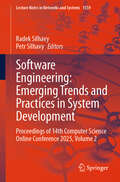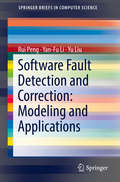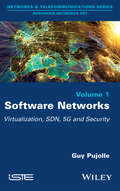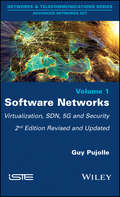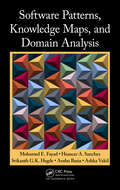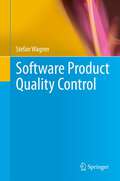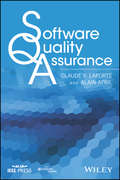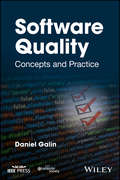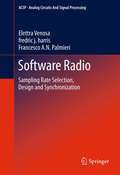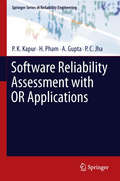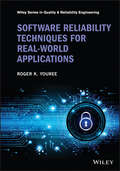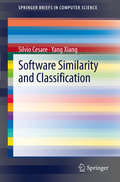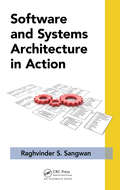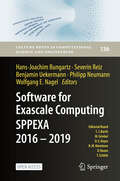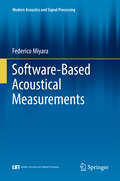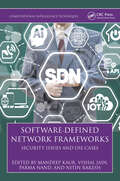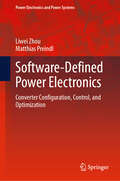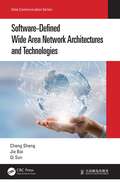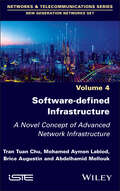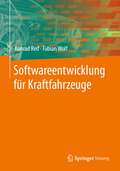- Table View
- List View
Software Engineering: Proceedings of 14th Computer Science Online Conference 2025, Volume 2 (Lecture Notes in Networks and Systems #1559)
by Radek Silhavy Petr SilhavyThis book discovers peer-reviewed research from an international research conference that unites experts in software engineering, data science, artificial intelligence, cybernetics, and informatics. This book presents cutting-edge methods, practical case studies, and foundational advances that address real-world challenges across the computational spectrum. Whether you seek rigorous theory, proven development practices, or visionary perspectives on emerging technologies, this book provides a comprehensive resource for researchers, practitioners, and students committed to shaping the future of digital systems.
Software Fault Detection and Correction: Modeling and Applications (SpringerBriefs in Computer Science)
by Yu Liu Rui Peng Yan-Fu LiThis book focuses on software fault detection and correction processes, presenting 5 different paired models introduced over the last decade and discussing their applications, in particular to determining software release time. The first work incorporates the testing effort function and the fault introduction process into the paired fault detection and fault correction models. The second work incorporates fault dependency, while the third adopts a Markov approach for studying fault detection and correction processes. The fourth work considers the multi-release property of various software, and models fault detection and correction processes. The last work classifies faults into four types and models the fault-detection and correction processes. Enabling readers to familiarize themselves with how software reliability can be modeled when different factors need to be considered, and how the approaches can be used to analyze other systems, the book is important reference guide for researchers in the field of software reliability engineering and practitioners working on software projects. To gain the most from the book, readers should have a firm grasp of the fundamentals of the stochastic process.
Software Networks
by Guy PujolleThe goal of this book is to describe new concepts for Internet next generation. This architecture is based on virtual networking using Cloud and datacenters facilities. Main problems concern 1) the placement of virtual resources for opening a new network on the fly, and 2) the urbanisation of virtual resource implemented on physical network equipment. This architecture deals with mechanisms capable of controlling automatically the placement of all virtual resources within the physical network. In this book, we describe how to create and delete virtual networks on the fly. Indeed, the system is able to create any new network with any kind of resource (e.g., virtual switch, virtual routers, virtual LSRs, virtual optical path, virtual firewall, virtual SIP-based servers, virtual devices, virtual servers, virtual access points, and so on). We will show how this architecture is compatible with new advances in SDN (Software Defined Networking), new high-speed transport protocol like TRILL (Transparent Interconnection of Lots of Links) and LISP (Locator/Identifier Separation Protocol), NGN, IMS, Wi-Fi new generation, and 4G/5G networks. Finally, we introduce the Cloud of security and the virtualisation of secure elements (smartcard) that should definitely transform how to secure the Internet.
Software Networks: Virtualization, SDN, 5G, and Security
by Guy PujolleSoftware Networks describe new concepts for the Internet's next generation. This architecture is based on virtual networking using Cloud and datacenter facilities. The main problems to be dealt with are the placement of virtual resources for opening a new network on the fly, and the urbanization of virtual resources implemented on physical network equipment. The digital architecture also deals with mechanisms capable of automatically controlling the placement of all virtual resources within the physical network. This book describes how to create and delete virtual networks on the fly. Indeed, the system is able to create any new network with any kind of virtual resource (e.g. switches, routers, LSRs, optical paths, firewalls, SIP-based servers, devices, servers, access points, etc.). Software Networks shows how this architecture is compatible with new advances in SDN (Software Defined Networking), new high-speed transport protocols such as TRILL (Transparent Interconnection of Lots of Links) and LISP (Locator/Identifier Separation Protocol), NGN, IMS, new generation Wi-Fi, and 4G/5G networks. Finally, the author introduces Clouds of security and the virtualization of secure elements (smartcards) that could certainly transform how to secure the Internet. For this second edition, the author addresses in five new chapters the importance of open source software for networks, mobile edge computing, fog networking, tactile internet – a network environment allowing remote access, and security – the use of Cloud of security, secure elements and the emergence of the blockchain.
Software Patterns, Knowledge Maps, and Domain Analysis
by Mohamed E. Fayad Huascar A. Sanchez Srikanth G.K. Hegde Anshu Basia Ashka VakilSoftware design patterns are known to play a vital role in enhancing the quality of software systems while reducing development time and cost. However, the use of these design patterns has also been known to introduce problems that can significantly reduce the stability, robustness, and reusability of software. This book introduces a new process fo
Software Product Quality Control
by Stefan WagnerQuality is not a fixed or universal property of software; it depends on the context and goals of its stakeholders. Hence, when you want to develop a high-quality software system, the first step must be a clear and precise specification of quality. Yet even if you get it right and complete, you can be sure that it will become invalid over time. So the only solution is continuous quality control: the steady and explicit evaluation of a product's properties with respect to its updated quality goals. This book guides you in setting up and running continuous quality control in your environment. Starting with a general introduction on the notion of quality, it elaborates what the differences between process and product quality are and provides definitions for quality-related terms often used without the required level of precision. On this basis, the work then discusses quality models as the foundation of quality control, explaining how to plan desired product qualities and how to ensure they are delivered throughout the entire lifecycle. Next it presents the main concepts and techniques of continuous quality control, discussing the quality control loop and its main techniques such as reviews or testing. In addition to sample scenarios in all chapters, the book is rounded out by a dedicated chapter highlighting several applications of different subsets of the presented quality control techniques in an industrial setting. The book is primarily intended for practitioners working in software engineering or quality assurance, who will benefit by learning how to improve their current processes, how to plan for quality, and how to apply state-of-the-art quality control techniques. Students and lecturers in computer science and specializing in software engineering will also profit from this book, which they can use in practice-oriented courses on software quality, software maintenance and quality assurance.
Software Quality Assurance
by Claude Y. Laporte Alain AprilThis book introduces Software Quality Assurance (SQA) and provides an overview of standards used to implement SQA. It defines ways to assess the effectiveness of how one approaches software quality across key industry sectors such as telecommunications, transport, defense, and aerospace. Includes supplementary website with an instructor’s guide and solutions Applies IEEE software standards as well as the Capability Maturity Model Integration for Development (CMMI) Illustrates the application of software quality assurance practices through the use of practical examples, quotes from experts, and tips from the authors
Software Quality: Concepts and Practice
by Daniel GalinThe book presents a comprehensive discussion on software quality issues and software quality assurance (SQA) principles and practices, and lays special emphasis on implementing and managing SQA. Primarily designed to serve three audiences; universities and college students, vocational training participants, and software engineers and software development managers, the book may be applicable to all personnel engaged in a software projects Features: A broad view of SQA. The book delves into SQA issues, going beyond the classic boundaries of custom-made software development to also cover in-house software development, subcontractors, and readymade software. An up-to-date wide-range coverage of SQA and SQA related topics. Providing comprehensive coverage on multifarious SQA subjects, including topics, hardly explored till in SQA texts. A systematic presentation of the SQA function and its tasks: establishing the SQA processes, planning, coordinating, follow-up, review and evaluation of SQA processes. Focus on SQA implementation issues. Specialized chapter sections, examples, implementation tips, and topics for discussion. Pedagogical support: Each chapter includes a real-life mini case study, examples, a summary, selected bibliography, review questions and topics for discussion. The book is also supported by an Instructor’s Guide.
Software Radio
by Elettra Venosa Francesco A. Palmieri Fredric J. HarrisThis book describes the design of Software Radio (SWR). Rather than providing an overview of digital signal processing and communications, this book focuses on topics which are crucial in the design and development of a SWR, explaining them in a very simple, yet precise manner, giving simulation results that confirm the effectiveness of the proposed design. Readers will gain in-depth knowledge of key issues so they can actually implement a SWR.
Software Receiver Design: Build Your Own Digital Communications System in Five Easy Steps
by C. Richard Johnson William A. Sethares Andrew G. KleinHave you ever wanted to know how modern digital communications systems work? Find out with this step-by-step guide to building a complete digital radio that includes every element of a typical, real-world communication system. Chapter by chapter, you will create a MATLAB realization of the various pieces of the system, exploring the key ideas along the way, as well as analyzing and assessing the performance of each component. Then, in the final chapters, you will discover how all the parts fit together and interact as you build the complete receiver. In addition to coverage of crucial issues, such as timing, carrier recovery and equalization, the text contains over 400 practical exercises, providing invaluable preparation for industry, where wireless communications and software radio are becoming increasingly important. A variety of extra resources are also provided online, including lecture slides and a solutions manual for instructors.
Software Reliability Assessment with OR Applications
by Hoang Pham P. C. Jha P. K. Kapur A. GuptaSoftware Reliability Assessment with OR Applications is a comprehensive guide to software reliability measurement, prediction, and control. It provides a thorough understanding of the field and gives solutions to the decision-making problems that concern software developers, engineers, practitioners, scientists, and researchers. Using operations research techniques, readers will learn how to solve problems under constraints such as cost, budget and schedules to achieve the highest possible quality level. Software Reliability Assessment with OR Applications is a comprehensive text on software engineering and applied statistics, state-of-the art software reliability modeling, techniques and methods for reliability assessment, and related optimization problems. It addresses various topics, including: unification methodologies in software reliability assessment; application of neural networks to software reliability assessment;software reliability growth modeling using stochastic differential equations;software release time and resource allocation problems; andoptimum component selection and reliability analysis for fault tolerant systems.Software Reliability Assessment with OR Applications is designed to cater to the needs of software engineering practitioners, developers, security or risk managers, and statisticians. It can also be used as a textbook for advanced undergraduate or postgraduate courses in software reliability, industrial engineering, and operations research and management.
Software Reliability Techniques for Real-World Applications (Quality and Reliability Engineering Series)
by Roger K. YoureeSOFTWARE RELIABILITY TECHNIQUES FOR REAL-WORLD APPLICATIONS SOFTWARE RELIABILITY TECHNIQUES FOR REAL-WORLD APPLICATIONS Authoritative resource providing step-by-step guidance for producing reliable software to be tailored for specific projects Software Reliability Techniques for Real-World Applications is a practical, up to date, go-to source that can be referenced repeatedly to efficiently prevent software defects, find and correct defects if they occur, and create a higher level of confidence in software products. From content development to software support and maintenance, the author creates a depiction of each phase in a project such as design and coding, operation and maintenance, management, product production, and concept development and describes the activities and products needed for each. Software Reliability Techniques for Real-World Applications introduces clear ways to understand each process of software reliability and explains how it can be managed effectively and reliably. The book is supported by a plethora of detailed examples and systematic approaches, covering analogies between hardware and software reliability to ensure a clear understanding. Overall, this book helps readers create a higher level of confidence in software products. In Software Reliability Techniques for Real-World Applications, readers will find specific information on: Defects, including where defects enter the project system, effects, detection, and causes of defects, and how to handle defects Project phases, including concept development and planning, requirements and interfaces, design and coding, and integration, verification, and validation Roadmap and practical guidelines, including at the start of a project, as a member of an organization, and how to handle troubled projects Techniques, including an introduction to techniques in general, plus techniques by organization (systems engineering, software, and reliability engineering) Software Reliability Techniques for Real-World Applications is a practical text on software reliability, providing over sixty-five different techniques and step-by-step guidance for producing reliable software. It is an essential and complete resource on the subject for software developers, software maintainers, and producers of software.
Software Similarity and Classification
by Yang Xiang Silvio CesareSoftware similarity and classification is an emerging topic with wide applications. It is applicable to the areas of malware detection, software theft detection, plagiarism detection, and software clone detection. Extracting program features, processing those features into suitable representations, and constructing distance metrics to define similarity and dissimilarity are the key methods to identify software variants, clones, derivatives, and classes of software. Software Similarity and Classification reviews the literature of those core concepts, in addition to relevant literature in each application and demonstrates that considering these applied problems as a similarity and classification problem enables techniques to be shared between areas. Additionally, the authors present in-depth case studies using the software similarity and classification techniques developed throughout the book.
Software Solutions for Engineers and Scientists
by Julio Sanchez Maria P. CantonSoftware requirements for engineering and scientific applications are almost always computational and possess an advanced mathematical component. However, an application that calls for calculating a statistical function, or performs basic differentiation of integration, cannot be easily developed in C++ or most programming languages. In such a case, the engineer or scientist must assume the role of software developer. And even though scientists who take on the role as programmer can sometimes be the originators of major software products, they often waste valuable time developing algorithms that lead to untested and unreliable routines. Software Solutions for Engineers and Scientists addresses the ever present demand for professionals to develop their own software by supplying them with a toolkit and problem-solving resource for developing computational applications. The authors' provide shortcuts to avoid complications, bearing in mind the technical and mathematical ability of their audience.The first section introduces the basic concepts of number systems, storage of numerical data, and machine arithmetic. Chapters on the Intel math unit architecture, data conversions, and the details of math unit programming establish a framework for developing routines in engineering and scientific code. The second part, entitled Application Development, covers the implementation of a C++ program and flowcharting. A tutorial on Windows programming supplies skills that allow readers to create professional quality programs. The section on project engineering examines the software engineering field, describing its common qualities, principles, and paradigms. This is followed by a discussion on the description and specification of software projects, including object-oriented approaches to software development. With the introduction of this volume, professionals can now design effective applications that meet their own field-specific requirements using modern tools and technology.
Software and Systems Architecture in Action (Applied Software Engineering Ser.)
by Raghvinder S. SangwanModern-day projects require software and systems engineers to work together in realizing architectures of large and complex software-intensive systems. To date, the two have used their own tools and methods to deal with similar issues when it comes to the requirements, design, testing, maintenance, and evolution of these architectures.Software and
Software for Exascale Computing - SPPEXA 2016-2019 (Lecture Notes in Computational Science and Engineering #136)
by Hans-Joachim Bungartz Wolfgang E. Nagel Philipp Neumann Severin Reiz Benjamin UekermannThis open access book summarizes the research done and results obtained in the second funding phase of the Priority Program 1648 "Software for Exascale Computing" (SPPEXA) of the German Research Foundation (DFG) presented at the SPPEXA Symposium in Dresden during October 21-23, 2019. In that respect, it both represents a continuation of Vol. 113 in Springer’s series Lecture Notes in Computational Science and Engineering, the corresponding report of SPPEXA’s first funding phase, and provides an overview of SPPEXA’s contributions towards exascale computing in today's sumpercomputer technology. The individual chapters address one or more of the research directions (1) computational algorithms, (2) system software, (3) application software, (4) data management and exploration, (5) programming, and (6) software tools. The book has an interdisciplinary appeal: scholars from computational sub-fields in computer science, mathematics, physics, or engineering will find it of particular interest.
Software im Automobil: Ein maschinell-generierter Literaturüberblick
by Fabian WolfDieses Fach- und Lehrbuch enthält die maschinengenerierten Zusammenfassungen einer Datenbankrecherche zum Thema „Software im Automobil“. Die Vorgabe der Stichworte, die Struktur und die Selektion der Inhalte wurde vom Autor vorgenommen. Darüber hinaus hat der Autor die enthaltenen Artikel durch Einleitungen und Bewertungen in einen übergreifenden Zusammenhang gebracht und kommentiert. Auf diese Weise ist ein Werk entstanden, das Studierenden sowie Berufseinsteigern einen breiten Überblick über das fachliche Feld sowie Hinweise zur weiterführenden Literatur gibt und auf die weitere Arbeit in diesem Bereich vorbereitet.
Software-Based Acoustical Measurements
by Federico MiyaraThis textbook provides a detailed introduction to the use of software in combination with simple and economical hardware (a sound level meter with calibrated AC output and a digital recording system) to obtain sophisticated measurements usually requiring expensive equipment. It emphasizes the use of free, open source, and multiplatform software. Many commercial acoustical measurement systems use software algorithms as an integral component; however the methods are not disclosed. This book enables the reader to develop useful algorithms and provides insight into the use of digital audio editing tools to document features in the signal. Topics covered include acoustical measurement principles, in-depth critical study of uncertainty applied to acoustical measurements, digital signal processing from the basics, and metrologically-oriented spectral and statistical analysis of signals. The student will gain a deep understanding of the use of software for measurement purposes; the ability to implement software-based measurement systems; familiarity with the hardware necessary to acquire and store signals; an appreciation for the key issue of long-term preservation of signals; and a full grasp of the often neglected issue of uncertainty in acoustical measurements. Pedagogical features include in-text worked-out examples, end-of-chapter problems, a glossary of metrology terms, and extensive appendices covering statistics, proofs, additional examples, file formats, and underlying theory.
Software-Defined Network Frameworks: Security Issues and Use Cases (Computational Intelligence Techniques)
by Vishal Jain Nitin Rakesh Parma Nand Mandeep KaurSoftware-Defined Networks (SDN) work by virtualization of the network and the Cognitive Software-Defined Network (CSDN) combines the efficiencies of SDN with cognitive learning algorithms and enhanced protocols to automatize SDN. Partial deployment of SDN along with traditional networking devices forms a Hybrid Software-Defined Network (HSDN). Software-Defined Network Frameworks: Security Issues and Use Cases consolidates the research relating to the security in SDN, CSDN, and Hybrid SDNs. The security enhancements derived from the use of various SDN frameworks and the security challenges thus introduced, are also discussed. Overall, this book explains the different architectures of SDNs and the security challenges needed for implementing them.Features: Illustrates different frameworks of SDN and their security issues in a single volume Discusses design and assessment of efficient SDN northbound/southbound interfaces Describes cognitive computing, affective computing, machine learning, and other novel tools Illustrates coupling of SDN and traditional networking – Hybrid SDN Explores services, technologies, algorithms, and methods for data analysis in CSDN The book is aimed at researchers and graduate students in software engineering, network security, computer networks, high performance computing, communications engineering, and intelligent systems.
Software-Defined Networking and Security: From Theory to Practice (Data-Enabled Engineering)
by Dijiang Huang Ankur Chowdhary Sandeep PisharodyThis book provides readers insights into cyber maneuvering or adaptive and intelligent cyber defense. It describes the required models and security supporting functions that enable the analysis of potential threats, detection of attacks, and implementation of countermeasures while expending attacker resources and preserving user experience. This book not only presents significant education-oriented content, but uses advanced content to reveal a blueprint for helping network security professionals design and implement a secure Software-Defined Infrastructure (SDI) for cloud networking environments. These solutions are a less intrusive alternative to security countermeasures taken at the host level and offer centralized control of the distributed network. The concepts, techniques, and strategies discussed in this book are ideal for students, educators, and security practitioners looking for a clear and concise text to avant-garde cyber security installations or simply to use as a reference. Hand-on labs and lecture slides are located at http://virtualnetworksecurity.thothlab.com/. Features Discusses virtual network security concepts Considers proactive security using moving target defense Reviews attack representation models based on attack graphs and attack trees Examines service function chaining in virtual networks with security considerations Recognizes machine learning and AI in network security
Software-Defined Networking: Extending SDN Control to Large-Scale Networks
by Abdelhamid Mellouk Fetia Bannour Sami Souihi<p>This book reviews the concept of Software-Defined Networking (SDN) by studying the SDN architecture. It provides a detailed analysis of state-of-the-art distributed SDN controller platforms by assessing their advantages and drawbacks and classifying them in novel ways according to various criteria.<p> <p>Additionally, a thorough examination of the major challenges of existing distributed SDN controllers is provided along with insights into emerging and future trends in that area.<p> <p>Decentralization challenges in large-scale networks are tackled using three novel approaches, applied to the SDN control plane presented in the book. The first approach addresses the SDN controller placement optimization problem in large-scale IoT-like networks by proposing novel scalability and reliability aware controller placement strategies. The second and third approaches tackle the knowledge sharing problem between the distributed controllers by suggesting adaptive multilevel consistency models following the concept of continuous Quorum-based consistency. These approaches have been validated using different SDN applications, developed from real-world SDN controllers.<p>
Software-Defined Power Electronics: Converter Configuration, Control, and Optimization (Power Electronics and Power Systems)
by Liwei Zhou Matthias PreindlPower electronic devices and systems are attracting growing attention due to the electrification of energy conversion systems being a key factor in efforts to reduce fuel combustion and achieve carbon neutrality. This book provides a concept of software-defined power electronics architecture to generalize the power converter design and control procedures with various interfaced applications. The ultimate objective is to construct a reconfigurable software-defined power electronics architecture with standardized atomic power modules that can be leveraged for different electrified energy resources, such as electric vehicle charging, electric motor traction, solar power, and wind power. Several advanced control and design techniques are introduced in detail to achieve the proposed concept with a high-performance energy conversion system, including optimization-based control and estimation, variable frequency soft switching, and passive component design and optimization. The proposed generalized architecture also contributes to avoiding redundant hardware and algorithms design procedures. Software-Defined Power Electronics: Converter Configuration, Control, and Optimization is a guide for engineers and academic researchers to the highly specialized skills required for working in the fields of power converter design and development.
Software-Defined Wide Area Network Architectures and Technologies (Data Communication Series)
by Cheng Sheng Jie Bai Qi SunStarting with problems and challenges faced by enterprise WANs, Software-Defined Wide Area Network Architectures and Technologies provides a detailed description of SD-WAN’s background and basic features, as well as the system architecture, operating mechanism, and application scenarios of the SD-WAN solution based on the implementation of Huawei SD-WAN Solution. It also explains key SD-WAN technologies and analyzes real SD-WAN deployment cases, affording readers with design methods and deployment suggestions for the SD-WAN solution. The information presented in this book is easy to understand and very practical. It enables you to become adept in the SD-WAN solution’s implementation and design principles. The book is intended for ICT practitioners, such as network technical support engineers, network administrators, and network planning engineers, to use in studying theory. Furthermore, it serves as reference material for network technology enthusiasts. Authors Cheng Sheng is the Chief Architect of Huawei’s SD-WAN Solution. He has nearly 20 years of experience in network product and solution design, as well as extensive expertise in product design and development, network planning and design, and network engineering project implementation. Jie Bai is an Architect of Huawei’s SD-WAN Solution. He is well versed in Huawei security products and SD-WAN Solution and has written books such as Huawei Firewall Technology Talk as well as Huawei Anti-DDoS Technology Talk. Qi Sun is a Senior Information Architect of Huawei, and he is knowledgeable in Huawei SD-WAN Solution, CloudVPN Solution, and Cloud Management Solution. He also participated in the information architecture design and delivery of multiple solutions.
Software-defined Infrastructure: A Novel Concept of Advanced Network Infrastructure (ISTE Invoiced)
by Abdelhamid Mellouk Tran Tuan Chu Mohamed Aymen Labiod Brice AugustinIn the era of the Internet of Things (IoT) and Digital Twins (DT), network infrastructures are rapidly evolving to meet industrial demands. Thus, we were motivated to explore the changing landscape of network deployment, management and utilization, driven by the rise of connected devices and emerging challenges. Software-defined Infrastructure focuses on the cutting-edge shift in hardware deployment and communication management methods, which enable unified, scalable and adaptive network management to support Healthcare IoT (H-IoT) communication, where real-time data transmission is essential to system success. The book presents a novel network concept and solutions for tackling the challenges in key areas such as 5G, and beyond, in network management, multipath transport protocols and edge computing. This book aims to simplify network management, improve remote patient monitoring communication and enhance patient outcomes. Through case studies and theoretical models, the book offers insights into the transformation of advanced networks in the H-IoT context and lays the foundation for innovative ideas in this research domain.
Softwareentwicklung für Kraftfahrzeuge
by Konrad Reif Fabian WolfIm ersten Teil dieses Lehrbuchs werden Funktions- und Softwareentwicklung für Kraftfahrzeuge eingeführt. Dabei wird auf den Prozess der strukturierten Funktions- und Softwareentwicklung von der Erhebung der Anforderungen über die Softwareerstellung bis zum Test sowie Reifegradmodelle eingegangen.Im zweiten Teil werden diese Prozesse aus Wissenschaft und Lehre mit etablierten Vorgehensweisen aus der industriellen Praxis konkretisiert. Die pragmatische Beschreibung der konkreten Vorgehensweisen ist eine Basis für die Ausgestaltung detaillierter Prozesse im Unternehmensalltag sowie deren tägliche Anwendung im Projektgeschäft.
